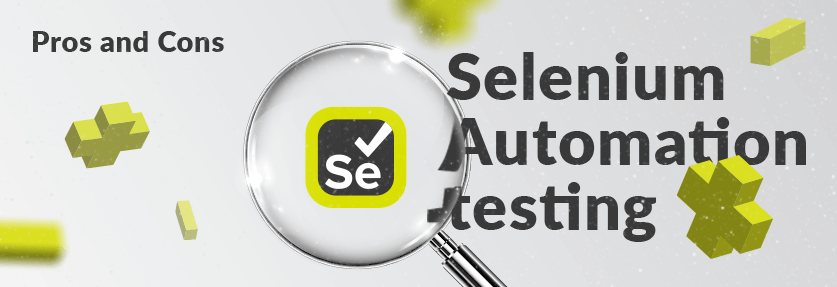Selenium Automation Testing: Pros and Cons
Numerous groundbreaking testing tools appear on the market each year. How does functional old Selenium Automation Testing manage to stay afloat still? Is it even still relevant in 2020? The short answer is yes, and no. Check out the pros and cons of Selenium Automation testing.
Why should you adopt Selenium in 2020? [Pros]
Finally, let’s talk about the advantages and disadvantages of using Selenium in 2020.
- Pay $0 Dollars
Much of Selenium’s popularity is owed to the fact that it’s totally free and yet some of its functionality still competes with paid products. There are literally no upfront costs or payments that you need to pay to use Selenium. This makes it the ideal option for independent developers and startups. You will find that even large corporations still hold on to Selenium as long as they can before upgrading to paid options.
- Compatible with Agile, DevOps, Continuous Delivery workflow
Surprisingly, Selenium was already following the Agile and DevOps narrative, even before these words were coined together. Selenium naturally abides by the main principles behind Agile, DevOps, or Continuous Delivery. Want to know how it achieves this?
Here’s how:
- Because of Selenium’s portability across all platforms, it doesn’t necessarily demand engineers to learn new languages—making it very flexible.
- Selenium is one of the few automation testing tools that can perfectly integrate with reputable development platforms such as Jenkins, Maven, TestNG, QMetry, SauceLabs, etc.
- Leveraging Selenium Grid’s parallel testing, developers can gather feedback quickly and work on the changes right away instead of waiting overnight for a test pass.
- Perfectly integrates with third-party tools
To compensate for some of its limitations, Selenium perfectly integrates with third-party tools—reporting tools, build systems, or any other Development/Testing Stack. Popular tools it integrates with are Selenium-Grid, TestNG, SauceLabs, and Extent, among many others.
- Fully supports mobile testing
Selenium makes it possible to test hybrid, native, or web mobile apps. It’s worth mentioning that you’ll need additional software to make this possible. Most developers opt for Appium and Selendroid, the two main options built specifically with Selenium on the mind.
- You don’t have to be a programming language polyglot
Thanks to translators, we don’t have to learn the language of every country we visit. It would’ve been a pain. Selenium offers language bindings so that testers don’t necessarily need to study a whole new programming language to use the tool. At present, the available official language bindings are C#, Java, Ruby, JavaScript, Kotlin, Python. Besides these, there are several other unofficial language bindings to accommodate the rest of the languages. Most notably, Selenium is the only free mainstream tool that accommodates Linux testing.
Most notably, Selenium is one of the few free mainstream tools that accommodate Linux testing.
- Large community support
Because of its numerous and unique advantages, Selenium has undoubtedly made many fans. Selenium possesses a staggering 26.82 percent market share of all software testing tools, and its top competitor UFT takes up just a little over 10 percent.
Overall, Selenium is supported by a vast community, from developers in major players like Google and Firefox to small startups. All of them actively contribute to the tool and documentation. As one of the pioneers in automation testing, Selenium has a combination of both old testers and new ones. With such a large community, it’s effortless to find Selenium learning materials. Youtube is flooded with hundreds of tutorials, the topic has over 25k followers on Quora, and 55k questions have been asked on the subject on StackOverflow.
Why should you consider alternatives to Selenium in 2020? [Cons]
There are certainly many perks to Selenium, but it also has its downsides.
- You need at least one programming language
Selenium has indeed done its best to solve the language problem by providing language bindings, but this is not enough. With Selenium, the tester has to have a good understanding of at least one programming language. But, what if the tester doesn’t know any programming language at all?
This is a dealbreaker for small businesses that often employ less skilled people in automated tests and reserve their best coders for only writing product features. Fortunately, new testing tools in 2020 are providing “codeless testing”, a feature that enables testers to write scripts and receive detailed feedback but with very little coding required. If you need “codeless testing”, you certainly need to look for a Selenium alternative.
- Image comparison is absent
One of the common challenges when conducting a QA process is automating image verification. While manually checking if an image is displayed correctly is very effective, it’s not that practical. Often, the tasks become repetitive, discouraging testers to check thoroughly. This explains why manual testing is often the primary source for bugs.
New innovative tools have an image comparison feature with a mockup of the actual image. Thus the program will compare the mockup to the one displayed during the test. Unfortunately, Selenium doesn’t have this crucial feature. A way around will be to get third-party software, but they are not as perfect as new testing automation tools.
- No direct Selenium tech support
It’s plausible that Selenium has an abundance of tutorials, questions, answers, and links to chat rooms where you can ask the community for help. But what happens if you have an original query? Besides, digging through all these different sources can be overwhelming.
On its ecosystem page, Selenium offers a shortlist of commercial consulting or service companies that you can contact if you need custom help. This is a dealbreaker, considering that its competitors actually provide direct custom consultation services to their clients.
- Primitive reporting capabilities
Unless you have implemented a third-party solution, the only way to capture a test failure in Selenium is through a Screenshot. This is unacceptable in 2020. Apart from testers; developers, project managers, and other stakeholders also need to see test results—preferably visualized in the form of charts, tables, and the supporting screenshots.
Unless you have implemented a third-party solution, the only way to capture a test failure in Selenium is through a Screenshot. This is unacceptable in 2020. Apart from testers; developers, project managers, and other stakeholders also need to see test results—preferably visualized in the form of charts, tables, and the supporting screenshots.
- It’s just free on paper
Selenium might be open source, but if you take a closer look, you will see that it’s actually not as cheap as you think. First, Selenium mostly requires experienced and expert automated testers, which translates into high wages for these employees. Furthermore, the setup and configuration process of a Test Framework from scratch is very time-consuming, which adds up to high initial cost if the requirement is urgent.
So there are two options, you can either get a free tool, however, you will have to get an expert QA and pay more in salary. Or, you may get a regular non-tech QA and an expensive tool, which translates to less expenditure on salary but more on subscriptions.
- Extended ROI time
With Selenium, test development is quite slow and its high initial time delays payback time. This can be a deal-breaker for small and medium-sized teams.
- Automation Challenges
Selenium lacks inbuilt solutions for specific tasks such as the ability to create a reliable and good framework according to product needs, working with waiters, working with possible poor locators, OS-based popup handling, Basic Authentication, and file handling.
The Takeaway
Selenium doesn’t overshadow all of the test automation tools on the market, especially if you have the budget for them. However, its monopolizing qualities will often make you think twice before you look away.
It all boils down to what your organization really needs. If you are old school and don’t want to partake in the “codeless trend”, you will mostly find Selenium to be satisfying.
In the case that you decide to go with Selenium, simply drop us a line. pwrteams’s highly experienced experts will provide you with detailed guidance and assistance during each and every step of the way.
READ ALSO:



